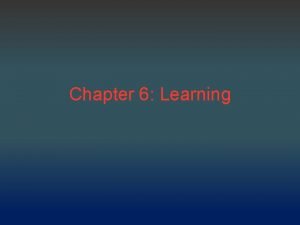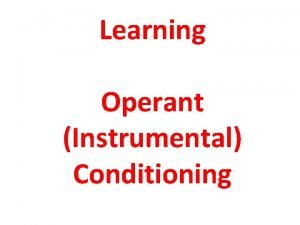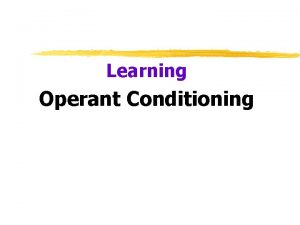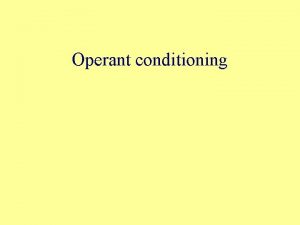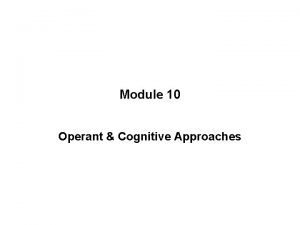OPERANT CONDITIONING Operant Conditioning and Reinforcement Operant Conditioningpeople









- Slides: 9

OPERANT CONDITIONING

Operant Conditioning and Reinforcement ■ Operant Conditioningpeople learn to do certain things because of the results of what they do ■ Reinforcement- the process by which a stimulus increases the chances that the preceding behavior will occur again

Primary and Secondary Reinforcers ■ Primary reinforcers- stimuli, such as food or warmth, that have reinforcement value without learning ■ Secondary reinforcers- stimuli that increase the probability of a response because of their association with a primary reinforce (money, attention, social approval) ■ Secondary reinforcers may acquire their value through a long chain of associations. For example, good grades can lead to a good college, lead to a good job, lead to more money, and social approval. ■ Or money because we have learned that it can be exchanged for primary reinforcers like food or shelter

Positive and Negative Reinforcers ■ Positive Reinforcers- encouraging stimuli that increase the frequency of a behavior when they are presented ■ Food, fun activities, and social approval are examples. You receive something you want after the behavior. But this can eventually go away or can be different for everyone. If I give you food for the behavior, eventually you’ll become full and not want anymore. My mom used to tell me if I got good grades I could play sports. But if she told me that and I hated sports, then it wouldn’t have mattered to me. ■ Negative Reinforcers- unpleasant stimuli that increase the frequency of behavior when they are removed ■ Discomfort, fear, and social disapproval are examples. For example, if I was a parent and I told my son to do something and he started screaming and crying and I gave in to him, I have just negatively reinforced him. Next time he doesn’t want to do something, he’ll yell and cry thinking that he’ll get his way.

Rewards and Punishments ■ Rewards- often assumed to be the same as positive reinforcers. But not exactly the same. Rewards are specific to that one person or animal. Positive reinforcement is something everyone usually wants. ■ Punishments- are quite different from negative reinforcement. The are unwanted events that decrease the behavior they follow. ■ For example, grades and sports. If you have bad grades you can’t play. The punishment is not playing on the team. The

Brainstorm examples of operant conditioning from your own lives. Positive Reinforcers Negative Reinforcers

Extinction ■ Extinction occurs because the events that had previously followed a stimulus no longer occur. ■ If you don’t eventually reward a dog for doing a trick, they will just stop doing the trick.

Shaping and Chaining ■ Shaping- a way of teaching behaviors in which one first reinforces small steps in the total activity ■ (Let’s teach all of the steps to ride a bicycle individually) ■ Chaining- each step of a sequence must be learned and must lead to the next until the final action is achieved ■ (Let’s use all the steps of how to ride a bicycle together so that we can now ride a bicycle)

Questions 1. What are the basic types of reinforcers? 2. What factors determine how effective a reinforcement will be? 3. How are shaping and chaining linked? 4. How are negative reinforcers and punishment different? 5. Do you think negative reinforcement or punishment is more likely to change behavior? Why? 6. Choose a task that you would like to teach someone using shaping and chaining. Write a description of each of the steps involved in the entire process.
 Skinner experiment
Skinner experiment What are schedules of reinforcement in psychology
What are schedules of reinforcement in psychology What is the little albert experiment
What is the little albert experiment Classical vs operant conditioning
Classical vs operant conditioning Operant conditioning
Operant conditioning Classical conditioning vs operant conditioning
Classical conditioning vs operant conditioning Classical and operant conditioning.
Classical and operant conditioning. Operant vs classical conditioning
Operant vs classical conditioning Operant vs classical conditioning
Operant vs classical conditioning Classical vs operant conditioning
Classical vs operant conditioning






